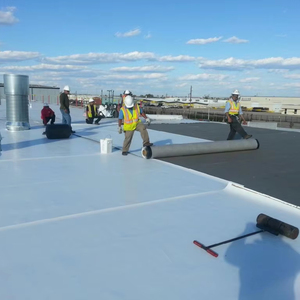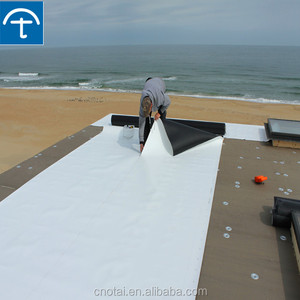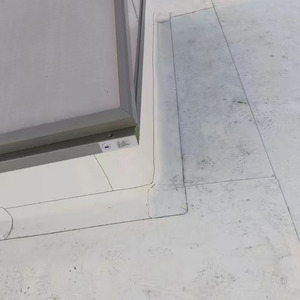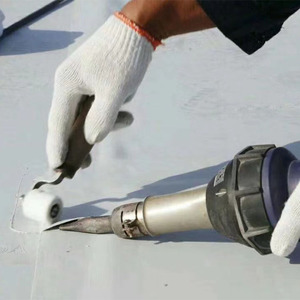(6886 products available)



















































































































































































































































A TPO membrane is a single-ply roofing membrane that commercial buildings use. It is made of three main components: polypropylene, ethylene, and rubber. The TPO membrane is popular because it is energy efficient and cost-effective. Its roofs are white, which helps reflect the sun's rays and keep buildings cool. A TPO waterproofing roofing membrane is a thermoplastic membrane widely used in commercial roofing due to its durability, cost-effectiveness, and ease of installation. Here are some types:
Reinforced TPO Membranes:
These membranes have polyester or fiberglass reinforcements sandwiched between the top layers. The reinforcements give the membrane extra strength to resist tearing and punctures. They come in different thicknesses. The 45-mil membranes are good for most flat roofs. The 60-mil membranes are even tougher and work well on roofs that get a lot of foot traffic or heavy stuff being moved around. The 80-mil membranes are the heaviest. They are mainly used on places like warehouses or big retail stores that need extra strength.
Non-Reinforced TPO Membranes:
These are lighter. They don’t have the extra fabric layer. Non-reinforced membranes are often used for smaller jobs or areas that don’t need as much strength.
White TPO Membranes:
Most TPO roofs are white. This color helps reflect the sun’s heat. A white TPO roof can keep the building cooler without running the air conditioning as much.
Black TPO Membranes:
Some places use black membranes instead. Black absorbs the sun’s heat. A black roof works well in colder climates where extra heat is wanted.
Scrim-Reinforced TPO Membranes:
Some membranes have a nylon scrim (mesh) layer. The scrim reinforces the membrane while keeping it lightweight.
Non-Reinforced TPO Membranes:
There are also non-reinforced TPO membranes. These are simpler. They don’t have the scrim mesh inside. Non-reinforced membranes are often used for smaller jobs or areas that don’t need as much strength.
The features and functions of TPO membranes include:
Energy efficiency
One outstanding quality of TPO is its remarkable energy efficiency. This is especially useful and relevant in sunny climates, where buildings absorb a lot of heat. TPO membranes are white and reflect sunlight. This prevents heat from entering the building, which reduces cooling costs. Lower air conditioning expenses mean businesses and homeowners save money every month. Reflecting UV rays helps keep interiors cool without needing as much electricity. For companies focused on cutting expenses or their carbon footprint, energy-efficient roofing membranes like TPO align with those goals.
Cost-effectiveness
EPDM and PVC are more widely used than TPO membranes, meaning their prices may vary. However, TPO membranes offer rapid installation and lower maintenance costs, making them a cost-effective option for commercial buildings. Their white color also makes them more energy-efficient, leading to long-term savings.
Durability
The TPO membrane is designed for long-term performance. Its thickness and composition provide excellent resistance to punctures, tears, and impacts. This durability minimizes the risk of leaks or damage during roof maintenance. The TPO membrane can withstand foot traffic from technicians and tools without tearing. Its flexibility allows it to absorb impacts from falling debris. Compared to other membranes, TPO repairs are straightforward. A technician can use hot air welds or TPO patches to fix small punctures without replacing large sections.
Easy installation
The TPO membrane is easy to install, which reduces labor costs. It can be mechanically fastened, ballasted, or glued, allowing installation on various rooftops. TPO membranes are lightweight and flexible, making them easy to carry and install on rooftops. Their simple attachment methods - mechanical fasteners, ballast stones, or adhesive - suit different rooftop designs and budgets.
Versatility
TPO membranes work well on rooftops of different shapes, like flat or slightly sloped ones. They also support solar panels, which companies install to save energy.
Residential Flat Roofs
TPO membranes are commonly used in residential houses with flat roofs. Their reflective surface helps to keep the house cool, reducing air conditioning costs. Additionally, their durability protects the roof from weather elements, prolonging its lifespan.
Commercial Buildings
Commercial buildings often have extensive roof areas. TPO membranes are ideal here due to their cost-effectiveness and ease of installation. The light-colored surface of TPO membranes assists in lowering the urban heat island effect in densely populated areas.
Green Roof Applications
TPO membranes can be used as a root barrier in green roof systems. They protect the underlying structures from roots and moisture while allowing rainwater to be absorbed by the plants above. Certain TPO products are designed to support plant life and promote sustainable roofing practices.
Hot Climates
The reflective nature of TPO roofing helps reduce heat absorption in hot climates. This leads to lower energy costs and a more comfortable indoor environment. Some TPO membranes have enhanced UV resistance, making them suitable for areas with high sun exposure.
Buildings with High Energy Costs
TPO roofing membranes can significantly reduce energy costs due to their reflective properties. Buildings that rely heavily on air conditioning can benefit from a TPO roof that reduces cooling needs. This not only saves money but also lessens the environmental impact by reducing energy consumption.
Roofing Renovations
TPO membranes are ideal for reroofing projects because they can be installed over most existing roof materials. This saves time and money compared to a complete roof tear-off. The reflective surface of a new TPO roof can revitalize an old roof's energy performance.
Buildings Targeting LEED Certification
TPO roofing membranes contribute to sustainable building practices that support LEED certification. Their energy efficiency, recyclability, and long lifespan make them a good choice for environmentally conscious designs. Their cool roofing properties can earn points in LEED's energy and atmosphere category.
Choosing the right TPO roofing membrane involves considering various factors to ensure optimal performance and longevity. Here are some tips to help select the right TPO waterproofing membrane:
Consider the Climate
When choosing a TPO roofing membrane, it is essential to consider the local climate. For instance, if the area experiences severe weather conditions, such as heavy rain or snow, or strong winds, a thicker membrane may be needed for better durability and protection. Additionally, TPO membranes with reinforced scrims offer better puncture resistance and durability in such regions. On the other hand, if the region has a warm climate, a white TPO membrane can help reduce cooling costs by reflecting sunlight.
Determine the Budget
It is important to select a TPO roofing membrane that one can afford. TPO membranes are generally less expensive than other single-ply membranes, such as EPDM. However, prices can vary based on factors such as thickness, brand, and additional features. While it may be tempting to choose the least expensive option, it is crucial to consider long-term savings. A durable and high-quality TPO membrane may have a higher upfront cost but can last longer, requiring fewer repairs.
Evaluate the Installation Process
The installation process of TPO roofing membranes can vary depending on the type of membrane. For example, mechanically attached membranes are easier to install and more cost-effective, while fully adhered membranes offer better wind resistance. Consider the expertise of the roofing contractor and the installation method when choosing a TPO membrane.
Check for Quality Certifications
Not all TPO membranes are of the same quality. Therefore, it is important to check for quality certifications, such as ASTM standards. Quality TPO membranes have better UV resistance, durability, and weather performance. Also, consider the product warranty. A reputable manufacturer offers a comprehensive warranty covering membrane defects, punctures, and weather-related damage.
Q1. What does TPO in TPO membranes mean?
A1. TPO stands for Thermoplastic Polyolefin. It is a single-ply roofing membrane that is widely used in commercial roofing.
Q2. What are the benefits of TPO roofing?
A2. TPO roofing has several benefits, including a highly reflective surface, fast and easy installation, energy efficiency, and cost-effectiveness.
Q3. What is a roofing membrane?
A3. A roofing membrane is a thin layer of material designed to prevent water from leaking into the building. It is usually installed on flat or low-slope roofs.
Q4. What are TPO membranes used for?
A4. TPO membranes are primarily used as roofing systems for commercial buildings. They are also used in residential buildings with flat or low-slope roofs.
Q5. Are TPO membranes durable?
A5. Yes, TPO membranes are durable. They can last between 20 and 30 years with proper maintenance. They are resistant to tears, impact damage, and weather elements.